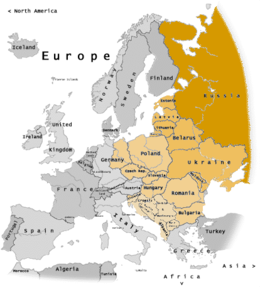Central and Eastern Europe


Central and Eastern Europe is a term encompassing the countries in Central Europe, the Baltics, Eastern Europe, and Southeast Europe (the Balkans), usually meaning former communist states from the Eastern Bloc and Warsaw Pact in Europe. Scholarly literature often uses the abbreviations CEE or CEEC for this term.[1][2][3] The Organisation for Economic Co-operation and Development (OECD) also uses the term "Central and Eastern European Countries (CEECs)" for a group comprising some of these countries.
Definitions[]
The term CEE includes the Eastern Bloc (Warsaw Pact) countries west of the post-World War II border with the former Soviet Union; the independent states in former Yugoslavia (which were not considered part of the Eastern bloc); and the three Baltic states – Estonia, Latvia, Lithuania (which chose not to join the CIS with the other 12 former republics of the USSR).
The CEE countries are further subdivided by their accession status to the European Union (EU): the eight first-wave accession countries that joined the EU on 1 May 2004 (Estonia, Latvia, Lithuania, Czech Republic, Slovakia, Poland, Hungary, and Slovenia), the two second-wave accession countries that joined on 1 January 2007 (Romania and Bulgaria) and the third-wave accession country that joined on 1 July 2013 (Croatia). According to the World Bank 2008 analysis, the transition to advanced market economies is over for all 10 countries that joined the EU in 2004 and 2007.[4]
The CEE countries include the former socialist states, which extend west of Russia, Belarus, Ukraine, Moldova; south of Finland and the Baltic Sea; north of Greece; and east of Austria, Italy, and Germany:
- Estonia - member of the European Union and NATO[5][6]
- Latvia - member of the European Union and NATO[5][6]
- Lithuania - member of the European Union and NATO[5][6]
- Poland - member of the European Union and NATO[5][6]
- Germany (Eastern part) - member of the European Union and NATO[5][6]
- Czech Republic - member of the European Union and NATO[5][6]
- Slovakia - member of the European Union and NATO[5][6]
- Hungary - member of the European Union and NATO[5][6]
- Romania - member of the European Union and NATO[5][6]
- Bulgaria - member of the European Union and NATO[5][6]
- Slovenia - member of the European Union and NATO[5][6]
- Croatia - member of the European Union and NATO[5][6]
- Albania - member of NATO
- Montenegro - member of NATO
- Serbia
- North Macedonia - member of NATO[5][6]
- Bosnia and Herzegovina
- Kosovo[7] (partially recognized territory)
According to the Organisation for Economic Co-operation and Development, "Central and Eastern European Countries (CEECs) is an OECD term for the group of countries comprising Albania, Bulgaria, Croatia, the Czech Republic, Hungary, Poland, Romania, the Slovak Republic, Slovenia, and the three Baltic States: Estonia, Latvia and Lithuania."[6]
The term Central and Eastern Europe (abbreviated CEE) has displaced the alternative term East-Central Europe in the context of transition countries, mainly because the abbreviation ECE is ambiguous: it commonly stands for Economic Commission for Europe, rather than East-Central Europe.[8]
See also[]
- Baltic states
- Central Europe
- Central and Eastern European Online Library
- European Union
- East-Central Europe
- Eastern Europe
- Eastern European Group
- Eurovoc
- Regions of Europe
- Southeastern Europe
- Three Seas Initiative
- Visegrád Group
References[]
- ^ Inotai, András (Autumn 2009). "BUDAPEST—Ghost of Second-Class Status Haunts Central and Eastern Europe". Europe's World. Archived from the original on 2013-01-12. Retrieved 2012-09-04.
- ^ Z. Lerman, C. Csaki, and G. Feder, Agriculture in Transition: Land Policies and Evolving Farm Structures in Post-Soviet Countries, Lexington Books, Lanham, MD (2004), see, e.g., Table 1.1, p. 4.
- ^ J. Swinnen, ed., Political Economy of Agrarian Reform in Central and Eastern Europe, Ashgate, Aldershot (1997).
- ^ Unleashing Prosperity: Productivity Growth in Eastern Europe and the Former Soviet Union, World Bank, Washington (2008), p. 42
- ^ Jump up to: a b c d e f g h i j k l m "CEE countries". 9 August 2011.
- ^ Jump up to: a b c d e f g h i j k l m n Directorate, OECD Statistics. "OECD Glossary of Statistical Terms - Central and Eastern European Countries (CEECs) Definition". stats.oecd.org.
- ^ Kosovo is the subject of a territorial dispute between the Republic of Kosovo and the Republic of Serbia. The Republic of Kosovo unilaterally declared independence on 17 February 2008. Serbia continues to claim it as part of its own sovereign territory. The two governments began to normalise relations in 2013, as part of the 2013 Brussels Agreement. Kosovo is currently recognized as an independent state by 97 out of the 193 United Nations member states. In total, 113 UN member states are said to have recognized Kosovo at some point, of which 15 later withdrew their recognition.
- ^ "UNECE Homepage". www.unece.org.
- Regions of Europe
- Geographical neologisms
- Central Europe
- Southeastern Europe
- Eastern Europe